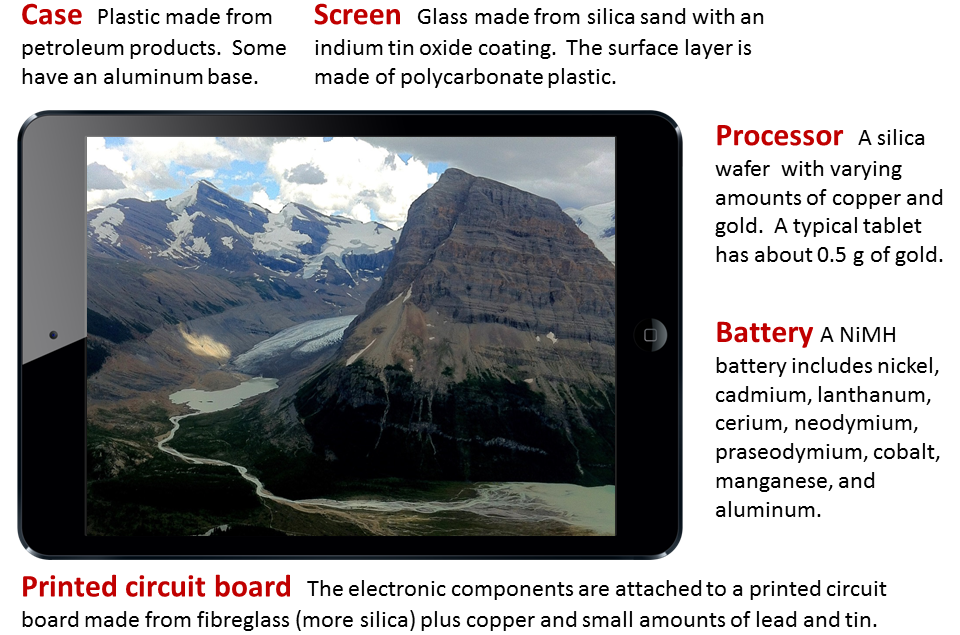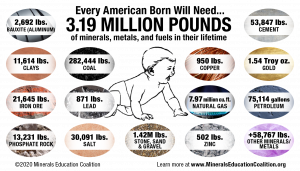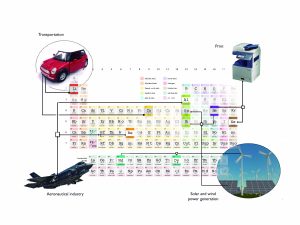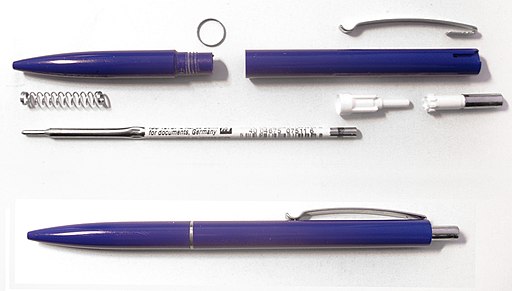9.1 Importance of Mineral Resources
Carolina Londono Michel

As the saying goes: “If you can’t grow it, you have to mine it”. Think about it. If you account for the totality of all products used in modern society, you will find out either we planted them/they grew, or we extracted them from Earth. This includes water as well as all the other raw materials that we need to construct things like roads, dams, and bridges, or manufacture things like plates, toasters, and telephones. Even most of our energy resources come from Earth, including uranium and fossil fuels, and much of the infrastructure of this electrical age depends on copper (Figure 9.1.2) [3]

Virtually everything we use in our lives comes from Earth. Let’s take a tablet as an example (Figure 9.1.2). Most of the case is made of a plastic known as ABS, which is made from either gas or petroleum. Some tablets have a case made from aluminum. The glass of a touch screen is made mostly from quartz combined with smaller amounts of sodium oxide (Na2O), sodium carbonate (Na2CO3), and calcium oxide (CaO). To make it work as a touch screen, the upper surface is coated with indium tin oxide. When you touch the screen, you’re actually pushing a thin layer of polycarbonate plastic (made from petroleum) against the coated glass—completing an electrical circuit. The computer can then figure out exactly where you touched the screen. Computer processors are made from silica wafers (more quartz) and also include a significant amount of copper and gold. Gold is used because it is a better conductor than copper and doesn’t tarnish the way silver or copper does. Most computers have nickel-metal-hydride (NiMH) batteries, which contain nickel, of course, along with cadmium, cobalt, manganese, aluminum, and the rare-earth elements lanthanum, cerium, neodymium, and praseodymium. The processor and other electronic components are secured to a circuit board, which is a thin layer of fiberglass sandwiched between copper sheets coated with small amounts of tin and lead. Various parts are put together with steel screws that are made of iron and molybdenum.
That’s not everything that goes into a tablet computer. But to make just those components we need a pure-silica sand deposit, a salt mine for sodium, a rock quarry for calcium, an oil well, a gas well, an aluminum mine, an iron mine, a manganese mine, a copper-molybdenum-gold mine, a cobalt-nickel mine, a rare-earth element and indium mine, and a source of energy to transport all the materials, process them, put them together, and finally transport the computer to your house or the store where you bought it [3]. Production of resources has markedly increased to meet the demand that our modern lives create. Figure 9.1.3 shows the resources that every American born will need in the average lifetime.


Exercise 9.1 Where does it come from?

Look around you and find at least five objects (other than a computer or a phone) that have been made from materials that were mined, quarried, or extracted from an oil or gas well. Try to identify the materials involved and think about where they might have come from. This pen is just an example.
Oxides of a series of fifteen metallic elements, from lanthanum to lutetium, and of three other elements: ytrium, thorium, and scandium. Their name refers to their very low concentrations on Earth's crust.

